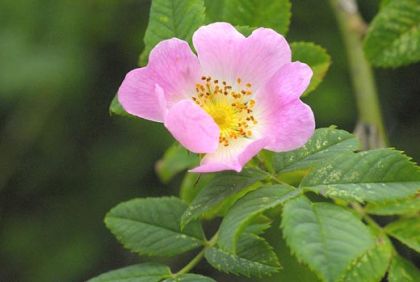Fragrant and well loved shrub of our hedgerows, Dog-rose produces pink or white flowers from June to August. The five-petalled flowers (3-5cm across) are borne on green arching branches with curved thorns and behind the petals, the sepals bend back after the flowers have opened. At the centre of each rose is a cluster of yellow stamens. The pretty pinnate leaves have 5 – 7 broad, hairless leaflets. In autumn, the fruits are red hips which shed their sepals before ripening. This is a native plant which belongs to the family Rosaceae. Roses can be difficult to name and there are many hybrids.
I first came to know this lovely plant in Ballycorus, Co Dublin in 1978 and photographed it in Carrig-on-Bannow, Co Wexford in 2007.
If you are satisfied you have correctly identified this plant, please submit your sighting to the National Biodiversity Data Centre
The briars or stems of the Dog-rose feature in our folklore:
From Co Cavan: 'When a child was after being born, if it didn't pass urine they would burn a handful of briars under it and it would be all right then'.
From the National Folklore Collection, University College Dublin. NFC S 815:1 From Co Laois.
Rose hips are a very good source of Vitamin C and also Vitamins A, D and E. However, if eaten raw there may be mild nausea, vomiting, stomach ache and diarrhoea. A small glass of milk or water should be given to drink if hips are swallowed.
In the UK these fruits were gathered to make syrup during World War 2 as citrus fruits were not available. Schoolchildren collected them and were given money in return. The hips make very good jelly and wine also, but the liquid must be strained through very fine muslin as tiny little seeds are quite harsh on one's insides. In the past, children put those same little seeds down the jerseys of unsuspecting other children where they caused incredible itching hence some other names by which they were known – Itchybacks, Cow-itches and Ticklers.




